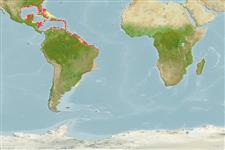Preferred temperature (Ref.
123201): 23.5 - 28.1, mean 27.3 °C (based on 864 cells).
Phylogenetic diversity index (Ref.
82804): PD
50 = 0.5002 [Uniqueness, from 0.5 = low to 2.0 = high].
Bayesian length-weight: a=0.00692 (0.00556 - 0.00861), b=3.04 (2.99 - 3.09), in cm total length, based on LWR estimates for this species (Ref.
93245).
Trophic level (Ref.
69278): 4.2 ±0.6 se; based on diet studies.
Widerstandsfähigkeit (Ref.
120179): mittel, Verdopplung der Population dauert 1,4 - 4,4 Jahre. (K=0.3-0.49; tm=4; tmax=7; Fec=3 million).
Prior r = 0.87, 95% CL = 0.58 - 1.31, Based on 2 data-limited stock assessments.
Fishing Vulnerability (Ref.
59153): Moderate to high vulnerability (46 of 100).
🛈
Climate Vulnerability (Ref.
125649): Very high vulnerability (86 of 100).
🛈
Nutrients (Ref.
124155): Calcium = 25.4 [15.4, 38.4] mg/100g; Iron = 0.523 [0.319, 0.792] mg/100g; Protein = 20.3 [17.9, 22.5] %; Omega3 = 0.139 [0.065, 0.297] g/100g; Selenium = 34.5 [19.7, 59.5] μg/100g; VitaminA = 52.2 [18.4, 155.2] μg/100g; Zinc = 0.769 [0.560, 1.077] mg/100g (wet weight);
